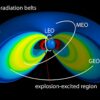Astronomers from the University of Hawaiʻi Institute for Astronomy (IfA) have uncovered the closest recorded occurrence of a star being torn apart by a supermassive black hole (SMBH). Using the All-Sky Automated Survey for Supernovae (ASAS-SN) system, on February 22, 2023, the team detected a sudden surge in brightness followed by a rapid dimming in the galaxy NGC 3799, located about 160 million light-years from Earth.
“While black holes destroying stars have been seen before, this is the first one we have seen this close using visible light,” said Willem Hoogendam, an IfA graduate student who co-led the research. “This could give us a much better understanding of how SMBHs grow and collect material around them.”
Follow-up observations were taken with IfA’s Asteroid Terrestrial Last Alert System (ATLAS) telescopes on Maunaloa and Haleakalā, W.M. Keck Observatory on Maunakea, and other ground- and space-based observatories. Hoogendam, working with fellow IfA grad student Jason Hinkle and faculty advisor Ben Shappee, analyzed these data to determine that the burst of brightness was caused by a Tidal Disruption Event (TDE).
TDEs happen when a star gets too close to a SMBH and is torn apart by its strong gravitational force, with the black hole devouring the star’s mass. Research findings will be published in the Monthly Notices of the Royal Astronomical Society.
“This discovery suggests that black holes ripping stars apart nearby could be more common than previously thought—we just haven’t witnessed it happening frequently,” said Hoogendam.
Rare find
The intense brightness produced by the star’s mass feeding the black hole creates a luminous flare, which all-sky surveys like ASAS-SN can observe. While such events have been detected far away from Earth, finding one relatively close by is rare. ASASSN-23bd, as the event is known, is a remarkable nearby TDE, making it an excellent subject for further study.
The astronomers found that ASASSN-23bd was unlike many other TDEs they had observed before:
It emitted much less energy than previous TDEs
It was the closest TDE discovered using visible light
Its change in brightness happened about twice as fast as most TDEs
ASASSN-23bd is in a unique category of objects known as low luminosity and Fast TDEs
Provided by
University of Hawaii at Manoa
Citation:
Star ripped apart by black hole in rare discovery (2024, March 6)



